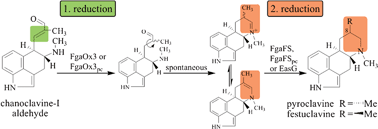In vitro conversion of chanoclavine-I aldehyde to the stereoisomers festuclavine and pyroclavine controlled by the second reduction step†
Abstract

* Corresponding authors
a
Philipps-Universität Marburg, Institut für Pharmazeutische Biologie und Biotechnologie, Deutschhausstraβe 17A, D-35037 Marburg, Germany
E-mail:
shuming.li@Staff.uni-Marburg.de
Fax: 0049-6421-2825365
Tel: 0049-6421-2822461
b Philipps-Universität Marburg, Fachbereich Chemie, Hans-Meerwein-Straβe, Marburg, Germany

 Please wait while we load your content...
Something went wrong. Try again?
Please wait while we load your content...
Something went wrong. Try again?
M. Matuschek, C. Wallwey, B. Wollinsky, X. Xie and S. Li, RSC Adv., 2012, 2, 3662 DOI: 10.1039/C2RA20104F
To request permission to reproduce material from this article, please go to the Copyright Clearance Center request page.
If you are an author contributing to an RSC publication, you do not need to request permission provided correct acknowledgement is given.
If you are the author of this article, you do not need to request permission to reproduce figures and diagrams provided correct acknowledgement is given. If you want to reproduce the whole article in a third-party publication (excluding your thesis/dissertation for which permission is not required) please go to the Copyright Clearance Center request page.
Read more about how to correctly acknowledge RSC content.
 Fetching data from CrossRef.
Fetching data from CrossRef.
This may take some time to load.
Loading related content
